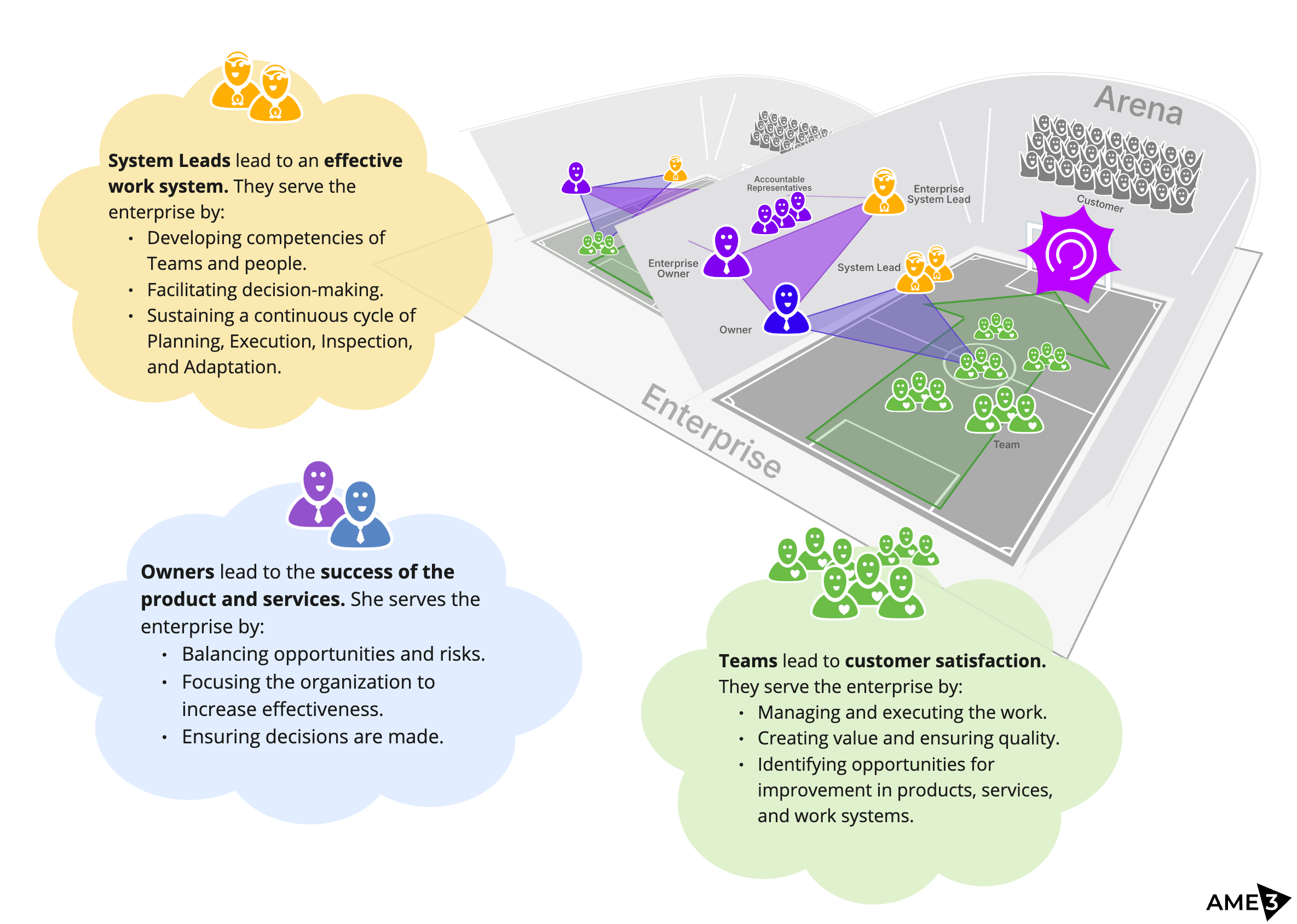The Team
Leading to Customer Satisfaction
In the previous two chapters, we highlighted the leadership of System Leads and Owners through the narratives of two companies. This part will concentrate on the often underestimated leadership function of the Team, further enriching these stories.

Example: Start-up
What motivates people: Autonomy, Mastery, and Purpose – Drive, by Dan Pink
In the early years of the start-up, hardly anyone thought about leadership or management. Everything seemed to happen naturally and felt quite organic.
New ideas were pursued with vigor when they ignited a spark of excitement within the Team. Given that the purpose of any activity serves as a significant catalyst for motivation, every Team member was naturally driven to cater to customer needs, all in the pursuit of positive feedback.
Surely, in many cases, it was more about experimenting. Whether there was indeed a customer need was just a hypothesis. Likewise, new technical solutions were passionately developed, tested, and often discarded. Experts were consulted. If the proposed solutions were suitable, these experts often joined the Team, as enthusiasm is known to be contagious.
You cannot not lead. – Inspiriert by Paul Watzlawick
^43c9aa
Parts 1 and 2 showed that this naturalness was in danger of being lost after the period of early growth. AME3 in conjunction with the application of frameworks like Scrum and later the LeSS framework helped the employees preserve the naturalness of the early years.
The organization discovered that work flows more efficiently when Teams are empowered to make timely decisions independently. This autonomy extended to their commitment to creating value for customers.
Thus, it remains entirely self-evident that all the work is self-managed by the team members. Especially when this means close coordination with other teams, customers and suppliers.
Therefore, the System Lead ensured that every employee received leadership and communication training. This significantly contributed to the Teams’ performance improvement.
Not the Owner leads the Team through decisions, but the Team leads the Owner to the decisions
As the company expanded, the primary focus of creating solutions that enhance customer satisfaction remained with the Teams. Yet, customer satisfaction isn’t the sole interest of a business. Our start-up also had to make tough decisions that weren’t always in favor of all potential customers to maintain profitability and focus. Naturally, these decisions were made by the Owner. However, the data and intelligence needed for these decisions, and even the identification of which decisions needed to be made, came from the experts within the Teams.
The Owner and Teams engaged in a continuous feedback loop of Matches (Sprints) and Tournaments. This process, facilitated by System Leads, helped them develop a nuanced understanding on how to delegate. They learned who needs to make decisions, how these decisions should be made, and when to involve or inform others.
Example: Medium-Sized Enterprise
The Team’s situation within the medium-sized Enterprise varies significantly from one Arena to another, and even within the Arenas themselves.
The Arena, focused on the 3D printer machine tool as a Arena Product, shares many similarities with our start-up example, despite the product itself being of a completely different nature. When this Arena was created, new Teams were formed with employees from other parts of the enterprise and by hiring new experts. Old rules and structures ceased to exist from one day to another. With a fresh start in mind, employees readily embraced and championed this new approach to work. These process also developed a strong sense of customer satisfaction by the teams.
The Arena of the laser welding tool family, already familiar with Lean and Agile methods, found the transition to AME3 initially subtle. However, the new overarching structure began to address deeply rooted problems tied to team dependencies. They now had a platform to address these issues during the Inspect and Adapt phases of Matches and Tournaments. Yet, team reorganization, and the learning and unlearning of practices, remain an integral part of this routine.
Since the establishment of the first two Arenas, three more have been thoughtfully created in line with the Enterprise’s strategy for evolution. A significant challenge for these Arenas is that employees are organized into specialized groups, such as business analysts or data engineers. This structure contributes to a diminished sense of customer satisfaction and identification with the shared Arena Product.
However, the new Arenas can now leverage the experiences of the initial ones. Teams and System Leads from existing Arenas are transitioning to the newly created ones, serving as on-the-job mentors. System Leads facilitate lightweight exchange formats between the Arenas to maintain the flow of knowledge.
Rules
AME3 establishes rules that foster the development and flourishing of the leadership system. Here are the rules connected with the Team.
Team
The Team is a leadership function in AME3 focused on improving customer satisfaction. Teams develop, provide, and maintain the Arena Product with stable membership. Each Team is supported by at least one System Lead.
- A Team leads to improved customer satisfaction.
- An Arena consists of one or multiple Teams.
- All teams in an Arena do all the work to develop, provide, and maintain the Arena Product.
- The Team has a stable number of employees over at least one Match, preferably for much longer.
- Each employee is a member of only one Team at a time.
- The Teams are responsible for keeping all work transparent.
- Each Team is supported by at least one System Lead.
- Team members may have different qualifications and experience. Additional roles may be defined by the Team or System Lead.
Conclusion
The Teams are leading to customer satisfaction. They serve the enterprise by:
- Managing and executing the work.
- Creating value and ensuring quality.
- Identifying opportunities for improvement in products, services, and work systems.
Continue reading about the meaning and functioning of AME3’s Leadership System.